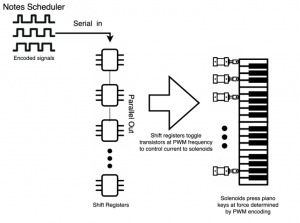This week, after scoping out our project extensively for our design presentation, we began focusing on our proof of concept design. We also received the raspberry pi, five solenoids, transistors, and shift registers we ordered for testing out specific metrics for our physical system. To accomplish this, we defined what metrics we want to collect and how we can determine a successful proof of concept. For the metrics, we plan on first testing the extension length of the solenoid piston and how far we will need to position it on top of the keys. This will impact our overall physical design and help us understand the structure of the system. Next, we will write simple test programs on a microcontroller to drive the solenoid at different rates and with various PWM encodings to get an optimal range of pressing speed and power. We will use this data to map the amplitude data gathered from the audio processing to how we press the piano key to best represent this. Additionally, we will create preliminary circuit to isolate the whole physical system pipeline within just 5 solenoids. In our testing, we will serially send out bits to our SIPO (Serial-in, Parallel-out) shift registers representing which notes to play. The parallel output is connected to the transistors, which control the flow of current from the power source to the solenoids.(See diagram below from our design presentation)

Building a scaled-down version of our physical system pipeline will allow us to not only understand how to use our parts and tools to create the whole flow of data, but also to measure our current draw and voltage requirements and extrapolate the proper power source requirements for the whole system for our 5- solenoid test. By colleting all these metrics, we will have a good understanding of the feasibility of scaling the system up to 69 keys and it will highlight any design choices that we need to focus from the rest of the project to best facilitate the physical system.
